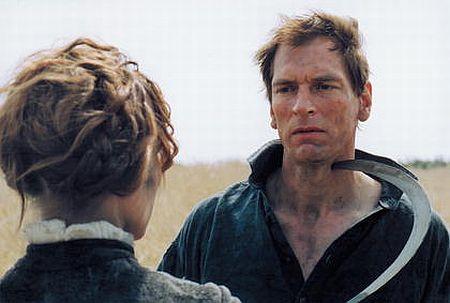
Romasanta: The Werewolf Hunt (Movie Review)
A toothsome young woman swoons through a lambent wheat field in search of her missing lover. Her eyelids labor to stay parted as her delicate frame works against a puckering bullet wound in her upper back. The woman, Barbara, bends to pick up an abandoned scythe amid the rustling stalks of flaxen grain and nearly collapses from the strain on her torn wing. She steadies herself and continues her desperate, heart-breaking enterprise. The golden meadow in mid harvest works to disorient her time and again and she pauses, to grope feverishly at the torn adhesion on her back.
As she considers the blood from her injury a feathery touch on her ear calls Barbara to alert. She spins wildly, her hand extending the gritty grey blade of the sickle which goes whistling unobstructed through a heavy, autumnal, Spanish waft. Her cutting stroke comes to rest with benign tension at the throat of her elusive paramour. Barbara’s eyes momentarily cleared of the haze of physical pain burn instead with the incomparable disdain of an inamorata betrayed. This man, Manuel Blanco Romasanta, has taken from her more than trifling, figurative virtue; he has stolen her soul and now on point of a reaper she has the chance to return the cruelty.
“Romasanta: The Werewolf Hunt” is a 2004 film by Paco Plaza (dir. “Rec” and “Rec 2”). It recounts with a mixture of speculation fiction and fact the story of Spain’s first serial killer. Manuel Romasanta was convicted of 13 murders in 1852; in his defense he asserted that he was cursed and that the murders were committed after he had literally taken the form of a wolf.
The film picks up the story in 1850; Romasanta has settled down to live with a widower named Maria, her handicapped tween daughter Teresa and Maria’s comely younger sister Barbara. The area they live in has experienced a rash of grisly killings that have all been attributed to the local wolf population. Manuel makes his living as a traveling merchant and he convinces Maria to relocate under the guise of finding a special school for Teresa. Maria implores Barbara to stay behind at the farm citing Barbara’s obvious attraction to Manuel as an impediment to the new couple’s continued bliss.
Shortly after the trio leave Manuel returns to the farm without Maria or Teresa. He tells Barbara that her sister and niece are doing well and then promptly sets about the task of seducing the young beauty. The two enter into a short but torrid tryst that is quickly interrupted by the discovery of more bodies in the forest and the appearance of a crazed stranger who tries to shoot Manuel. Barbara eventually learns her family’s real fate as well as the malevolent nature of the man she has taken as a lover. With his killings brought to light Manuel takes flight, but what the ‘Wolfman of Allariz’ doesn’t suspect is that his greatest undoing may not be the tenacious police inspector but rather his former lover’s blood vendetta.
If it were simply the sum of its parts “Romasanta: The Werewolf Hunt” would be a top-shelf entry into the cinematic lycanthropy canon. Unfortunately, this lupine lark is a set of really elegant parts with nothing that feels like a true heart at the center. Perhaps it is the unsuccessful genre mixing that contributes most to this hollow impression. Paco Plaza’s film dabbles in horror, Conan-Doyle styled sleuthing, steamy seduction and sweeping period romance. All of this could have fused into an incredible tour-de-force had the film not insisted on laying everything bare to our eyes as it happened. A little more circumstantial mystery could have cast a stronger tone across the whole of the story and really worked to unsettle the viewer by giving us a chance to sit in uncertainty.
The choice was instead made to focus on Romasanta’s enigmatic affair with Barbara. The problem there is that the chemistry between Julian Sands (as Manuel) and Elsa Pataky (as Barbara) is never quite good enough to make the emotion work for the rest of the film. Much like the first paragraph of this review the central relationship of the movie just comes across like a passage from a weak romance novel, with a dashing serial killer playing the part of Fabio.
Paco Plaza has managed to deliver a sumptuous looking film here. The cinematography, the painterly lighting and the well rendered gore sequences are almost worth a look by themselves. Despite the lack of chemistry with one another Pataky and Sands manage to trade-off moments of reasonable smolder and do come together for one very memorable bathing sequence. There are a couple of surprising turns in the script, the wolves in ‘Romasanta’ look great and the opening sequence is a top notch table-setter.
If there had been a little more that was working between the actors or a little less information revealed as the story built I might have been a big fan. Alas, what do persist all too strongly in my mind are the schmaltzy, woman-in-love-with-dangerous-stranger clichés on display in the movie. This makes it hard to focus on the themes and unless your partial to Harlequin sentimentality it makes it impossible to fully absorb yourself in the atmosphere of the story.

